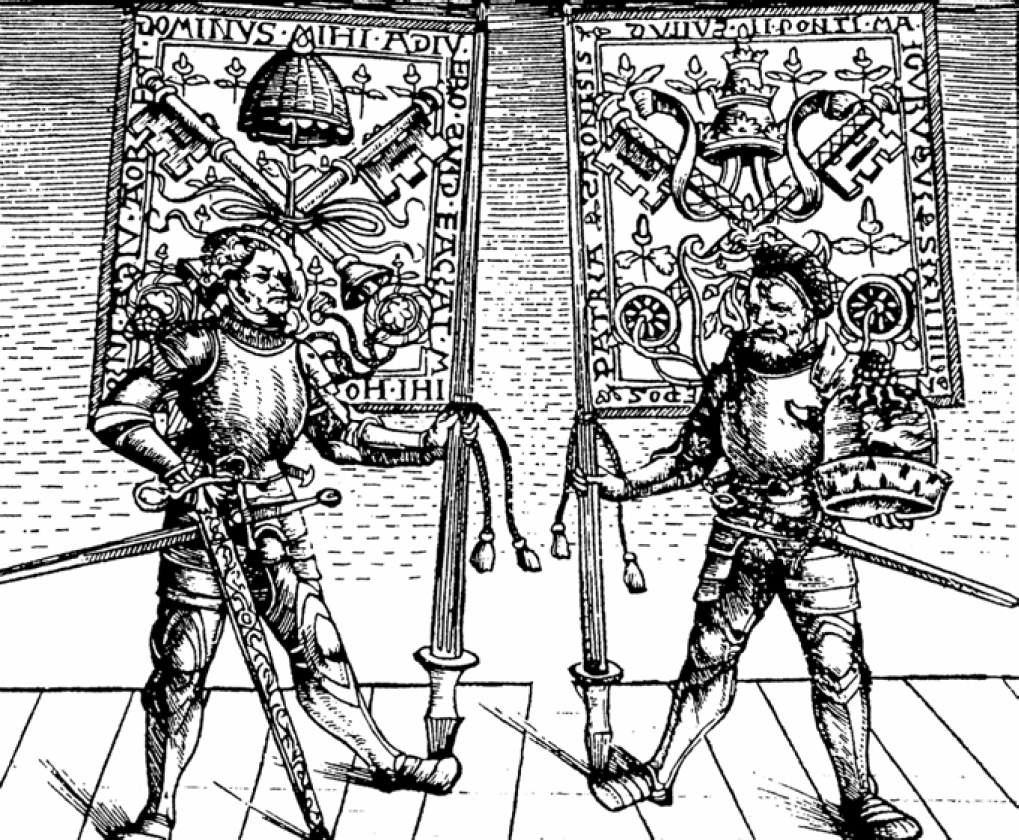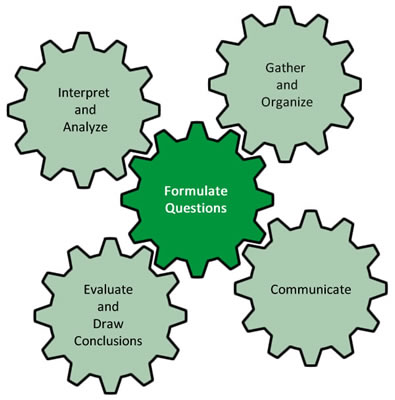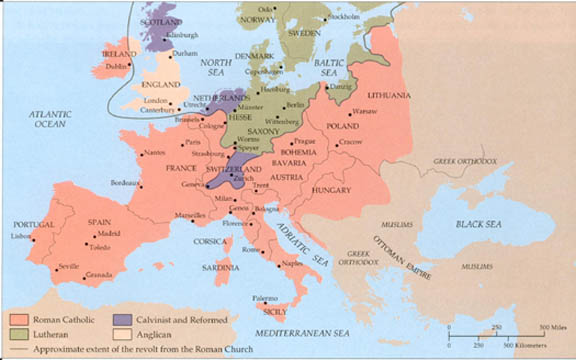CHY4U
World History Since the Fifteenth Century
Unit 1: 1450 - 1650: What Were They Thinking?
Activity 3: State of the World: 1450-1650 - Social, Economic and Political Context of Four Regions (Africa, Asia, Europe, Americas)

This image features the heralds of Pope Julius II holding the blessed sword and hat. These objects were blessed by popes and given to rulers who defended the Church’s interests through military exploits.
In this activity, you will establish the historical significance of events and people from four regions of the world: Africa, Europe, Japan, and North America. As you proceed through the activity, you will need to ask yourself two questions about the events and issues we consider, to determine their significance:
- Did it result in change?
- What does it reveal about the values and beliefs of the past?
Let’s briefly reexamine the image of the heralds. In order to understand if something has changed, we need context. Do you feel like you know enough about this era to establish that the image is connected to change? Probably not. Thus, throughout this activity, you will learn the context necessary to understand the sources. How about the second question? Does this image reveal something that you did not know about the beliefs and values regarding the papacy in this era?
 My Questions
My Questions
What questions could you ask that might help you better understand what this primary source reveals?
How Are These Things Significant?
In this activity, after you complete the Martin Luther and the Protestant Reformation activity, you will examine ONE of the FOUR subtopics (Malleus Maleficarum, Japan, Korea and Mesoamerica) and apply these two criteria of historical significance:
- Results in Change - did the primary source result in change?
- Reveals the Past - did the primary source reveal attitudes or beliefs of this era?
Martin Luther and the Protestant Reformation
The Christian Church wielded tremendous influence throughout Europe. Besides its millions of followers, the Church influenced rulers throughout the continent; so much so, that its edicts could shape domestic and foreign policy in kingdoms and empires. The Church also held territorial and financial powers; it owned the land upon which its monasteries and places of worship were built, and tithes provided tremendous wealth. It also directly controlled a region of Italy known as the Papal States.
Several events in the late 15th and early 16th century changed the responses of Europeans to the Church’s power. Julius II, the pope during the first decade of the century, engaged in both political and military undertakings. He made political allegiances with states against other powers, such as Venice, which encroached on Church interests, and he even controlled his own troops. At the siege of one Italian city, Julius II donned armor and marched with his soldiers, an act that earned him the nickname “the warrior pope”, and drew considerable scorn. One of his detractors, the scholar Erasmus, wrote a satire in which Julius II was barred entry into heaven; in the satire, Julius is asked this question while he stands outside the gates of Heaven: “ What sort of unnatural arrangement is it, that while you wear the robes of a priest of God, under them you are dressed in the bloody armor of a warrior?”
An official order or proclamation.
Mandatory donations given by the faithful.
|
Julius II’s successor, Leo X was independently wealthy himself, but also spent Church money lavishly. One of his major projects was St. Peter’s Basilica in Rome. Though it had been started decades earlier, new financing was needed if the project was to be completed. Leo X sanctioned the use of donations to continue the build. In some regions of Europe, those collecting the donations used controversial methods like the selling of indulgences to raise more funds. Indulgences were essentially a form of forgiveness issued immediately based on a good act committed by the recipient; instead of waiting for a priest to absolve the sin, the recipient was instantly absolved, and thus ready to enter Heaven. Popes had issued such indulgences to participants in the Crusades, arguing that their actions on behalf of the Church absolved them of their sins. During Leo’s papacy, a number of priests sold indulgences as a way to raise money for the building of the Basilica; it seemed that those giving money were not supporting the Basilica, but buying their way into heaven. In some cases, the indulgences were purchased not to cleanse the souls of the living, but to forgive the sins of dead relatives. |

Pope Leo X, 1518, painted by Raphael
In 1517, a monk named Martin Luther challenged the sale of indulgences (and other Church practices) by nailing his Ninety-Five Theses to a church door in Wittenberg, Germany. While this was not the first act of open rebellion against the Church, it was the most influential; it sparked the Protestant Reformation, a period during which various groups throughout Europe broke away from the Catholic Church and formed their own denominations. Like the events that had incited Martin Luther to write his Theses, the Reformation was not exclusively about faith and religion: economic, political, and social factors also played their roles.

Questioning Primary Sources
Below are some excerpts from the Ninety-Five Theses. Though you have been introduced to many primary sources so far, this will be your first close examination of a primary source. Thus, we should consider some questions that will help us effectively examine primary sources. Mouse over each green question mark to see a question, then click on it to see an explanation.
 Primary Source Questions
Primary Source Questions
Download and save this summary of primary source questions.
Take a closer look at the translation of the 95 Theses original text below.
Reflections on a Primary Source
Here is an example of a teacher using the Primary Source Questions to analyse a source.
Note that the teacher knows quite a lot of historical context that helps him to interpret the source. It can be helpful to read background information as you are reading to be able to connect the source with the historical context.
What Were the Consequences of the Reformation?
The Reformation spread quickly. By 1560, many states in northern Europe had adopted Lutheranism or other variations of Protestantism. While many of these conversions were spurred by the disapproval of the Church, some rulers found that there were other advantages to embracing new denominations: the land owned by the Church and the tithes it collected could now be claimed by rulers of the region, and not sent to the Pope, increasing their own wealth considerably.

The Catholic Church’s response came in several forms. At the Council of Trent in 1545, the Church reaffirmed many of its practices, especially those that were at odds with the Protestant faiths. Five years before the Council of Trent, a new religious order, the Jesuits, was founded in direct response to the Reformation. The Papal Bull which brought the Jesuit order into existence, Regimini Militantis Ecclesiae, provides insight into the order’s purpose: they took their inspiration from the military, and waged a spiritual war through attempts to convert non-Catholics throughout the entire world. As you will see, the Jesuits played a significant role in the spread of Christianity outside Europe.